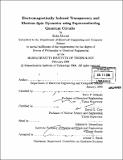Electromagnetically Induced Transparency and electron spin dynamics using superconducting quantum circuits
Author(s)
Murali, Kota, 1980-
DownloadFull printable version (14.58Mb)
Alternative title
EIT and electron spin dynamics using SQC
Other Contributors
Massachusetts Institute of Technology. Dept. of Electrical Engineering and Computer Science.
Advisor
Terry P. Orlando and David G. Corey.
Terms of use
Metadata
Show full item recordAbstract
This thesis is an exploration on superconducting devices, quantum optics, and magnetic resonance. Superconductive quantum circuits (SQC) comprising mesoscopic Josephson junctions can exhibit quantum coherence amongst their macroscopically large degrees of freedom. They feature quantized flux and/or charge states depending on their fabrication parameters, and the resultant quantized energy levels are analogous to the quantized internal levels of an atom. This thesis builds on the SQC-atom analogy to quantum optical effect associated with atoms, known as Electromagnetically Induced Transparency (EIT). An EIT (denoted as S-EIT) based technique has been proposed to demonstrate microwave transparency using a superconductive quantum circuit exhibiting two metastable states (e.g., a qubit) and a third, shorter-lived state (e.g., the readout state). This technique is shown to be a sensitive probe of decoherence, besides leading to the prospects of observing other interesting quantum optical effects like AC-stark effect in SQCs. (cont.) The second part of this thesis concerns a novel technique for sensitive detection of magnetic resonance using SQC-based resonance circuits. Superconducting quantum circuits are also known to sensitive detectors of magnetic fields. In particular, the effect of electron spin resonance signal on a Superconducting QUantum Interference Device (SQUID) based non-linear resonant circuit is derived. The electron spin resonance signal propagates as a non-linear behavior of the SQUID voltage, that can sensitively detect extremely small (less than 10-5 [Phi] 0) electron spin resonance signals.
Description
Thesis (Ph. D.)--Massachusetts Institute of Technology, Dept. of Electrical Engineering and Computer Science, 2006. Includes bibliographical references (p. 147-156).
Date issued
2006Department
Massachusetts Institute of Technology. Department of Electrical Engineering and Computer SciencePublisher
Massachusetts Institute of Technology
Keywords
Electrical Engineering and Computer Science.